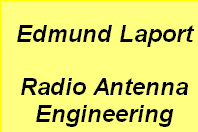

Antentop is FREE e-magazine devoted to Antennas and Amateur Radio an
Special page devoted to
The Inverted L Ham Antenna

Custom Search
|
ANTENTOP- 01- 2018 # 022 |
The Inverted L Ham Antenna |
|
|
|
|
The Inverted
L Ham Antenna |
|
|
|
|
|
|
By Robert M. See, W5LTD Credit Line: Radio and TV- news,
January 1959, pp.: 64- 65. |
|
|
|
|
Construction of simple antenna and matching
network that provides a good compromise in height, cost, and coverage. After moving into a new home it was hoped that a satisfactory
solution could be found to the problem of installing an amateur
antenna without detracting from an appearance of the neighborhood
landscaping. This, of course, ruled out any type feedline which
would hang suspended and flapping in the Oklahoma breeze. Naturally
the buried coax feedline and all- band vertical came to mind.
After considerable thought (this is always the hard part), it
was decided to modify the vertical radiator to include some horizontal
polarization. It was believed that this might increase the field
strength, on 80 and 40 meters, over that of a vertical- at least
within a 300-mile radius. In other words, we didn't want our signal
to skip our local friends. As a consequence, the Inverted L Antenna-
which is a compromise in height, cost, and coverage- was adopted. The utility pole was set 5 feet into the ground and
has withstood 70 mph wind gust without guy wires. It is located
on the rear of a city lot, nestled in a group of eastern red cedar
trees. It takes a sharp eye to detect any discontinuity in the
landscape. |
Radio and TV- news, January 1959 |
|
The XYL believes this to be the best part of the entire
installation, however, the author is partial to its operation
and the strong signal reports received. Figure 1 shows the horizontal radiation patterns on three bands for which the
antenna was designed. It would be possible to operate the antenna
on 15 and 10 meters with the proper matching networks but these
bands have not been investigated. |
Antenna Construction The vertical portion of the antenna is made from a
32.5-foot section of ½-inch I.D. copper water tubing. It
is mounted on 4-inch ceramic stand-off insulators which are, in
turn, fastened to the telephone pole. The copper tubing can be
purchased in coils of varying length and was used because it was
easy to handle and workable. The horizontal portion of the antenna
is 32.5 feet of # 12 AWG (2-mm) stranded copper antenna wire. |
|
|
|
|
|
|
|
Page- 17 |
|
 |
 |
|
 |
|
|
|||
Just for Fun:

Powered byIP2Location.com
Thanks for your time!
Last Updated:
January 2, 2020 21:21







